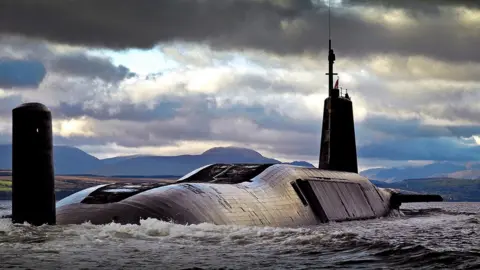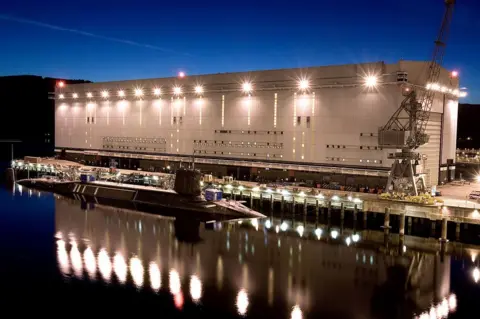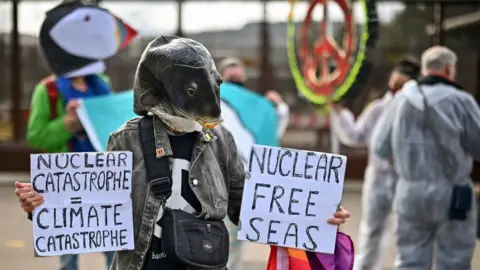What is Trident, how does it work and what does it cost?
 MOD
MODReports a test firing of a Trident missile from a Royal Navy submarine has failed for the second time in a row has refocused attention on the UK's nuclear capability.
The current Vanguard nuclear submarines are due to be replaced by Dreadnought boats in the early 2030s.
What is Trident and how does it work?
The Trident nuclear-weapons system is part of Britain's nuclear deterrent.
The logic is if the UK were under nuclear attack, it could launch a retaliatory strike on the aggressor, a concept known as mutually assured destruction.
The system includes four nuclear-powered Vanguard-class submarines, missiles and warheads.
Each submarine is designed to carry 16 Trident missiles, capable of delivering multiple warheads - but in recent years, they have carried eight missiles each, with a maximum of 40 warheads per boat.

The UK leases missiles from the US but these are fitted with a UK warhead.
The submarines can stay submerged for months at a time.
Since April 1969, the Royal Navy says, there has always been at least one nuclear-armed submarine patrolling at sea.
Two of the others are also armed and ready to be deployed at relatively short notice, while the fourth is able to undergo maintenance.
Where are the Trident submarines based?
Since the 1960s, the UK's nuclear submarines have been based at Faslane Royal Navy base near the Firth of Clyde, about 25 miles from Glasgow.
The nuclear warheads are stored at the nearby Coulport armaments depot on Loch Long.
 MOD
MODWhat does Trident cost?
Trident was acquired by Margaret Thatcher's Conservative government in the early 1980s, to replace the Polaris missile system the UK had had since the 1960s.
It cost £12.52bn - about £21bn in 2022-23 prices, according to a House of Commons Library briefing.
Annual running costs are estimated at 6% of the defence budget - about £3bn for 2023-24.
In 2007, Tony Blair's Labour government decided to renew the Trident submarine fleet.
And in 2016, the UK Parliament again voted to maintain Britain's nuclear capability.
The new Dreadnought boats are being built at Barrow-in-Furness, Cumbria, at an estimated cost of £31bn.
They are expected to be armed with existing Trident missile stocks, after their lifespan was extended to the 2040s.
How did the missile test fail?
The latest test was from HMS Vanguard off the east coast of the US, in January.
Defence Secretary Grant Shapps and the head of the navy were both on board.
The missile's booster rockets failed and it landed in the sea close to the launch site, according to the Sun newspaper, which first reported the malfunction.
It should have flown several thousand miles before landing harmlessly in the Atlantic between Brazil and West Africa.
The missile was not fitted with a nuclear warhead, as is normal during a test fire.
The Ministry of Defence blamed the malfunction on the test missile.
It said HMS Vanguard and its crew had "
proven fully capable" in their operations and the test had "reaffirmed the effectiveness of the UK's nuclear deterrent".
Although firing drills take place regularly, test firings are much rarer, not least because each missile costs about £17m.
The previous test firing from a UK submarine, in 2016, also ended in failure, when the missile veered off course.
Who decides whether to use Trident?
The decision to launch nuclear weapons can only be taken by the prime minister - or a designated survivor following a nuclear attack.
Two personnel must authenticate each stage of the firing process.
 PA Media
PA MediaThe firing control is not actually a "red button" but rather a trigger, modelled on the handgrip of a Colt "peacemaker" pistol.
Locked inside a safe on each of the submarines is a "letter of last resort" from the prime minister, containing instructions on what to do if all contact with the command system is lost following an overwhelming attack.
The precise contents of these letters are never disclosed.
They are destroyed unopened when a new prime minister is elected.
It is rumoured one of the tests of whether the UK has been hit by a nuclear strike is whether the Today programme is still broadcasting on BBC Radio 4.
Why is Trident controversial?
Some criticise the UK's nuclear capability on ethical grounds. Former Labour leader Jeremy Corbyn, for example, said he would never press the nuclear button.
Others object to the economic cost.
The Campaign for Nuclear Disarmament (CND) estimates the total bill for maintaining and replacing the Trident system over its lifespan could be as high as £205bn.
 Getty Images
Getty ImagesAnti-nuclear campaigners dispute the claim such weapons act as a "deterrent", pointing out nuclear powers have been involved in many wars since the atomic bomb's invention.
Some also say submarine-based weapon systems could become obsolete, as developments in underwater drone technology make them vulnerable to attack.
The SNP opposes the retention of Trident and has promised to negotiate the removal of nuclear weapons should Scotland become independent.
It describes nuclear weapons as "immoral, ineffective and expensive".
